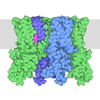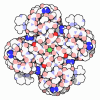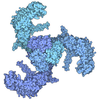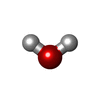+ Open data
Open data
- Basic information
Basic information
| Entry | Database: PDB / ID: 9eio | |||||||||
|---|---|---|---|---|---|---|---|---|---|---|
| Title | Cryo-EM structure of the mutant KCa2.2_F244S channel | |||||||||
 Components Components |
| |||||||||
 Keywords Keywords | TRANSPORT PROTEIN / Ion channel / Calmodulin binding protein. Membrane protein | |||||||||
| Function / homology |  Function and homology information Function and homology informationCa2+ activated K+ channels / small conductance calcium-activated potassium channel activity / membrane repolarization during atrial cardiac muscle cell action potential / calcium-activated potassium channel activity / positive regulation of potassium ion transport / inward rectifier potassium channel activity / establishment of protein localization to mitochondrial membrane / type 3 metabotropic glutamate receptor binding / establishment of protein localization to membrane / regulation of potassium ion transmembrane transport ...Ca2+ activated K+ channels / small conductance calcium-activated potassium channel activity / membrane repolarization during atrial cardiac muscle cell action potential / calcium-activated potassium channel activity / positive regulation of potassium ion transport / inward rectifier potassium channel activity / establishment of protein localization to mitochondrial membrane / type 3 metabotropic glutamate receptor binding / establishment of protein localization to membrane / regulation of potassium ion transmembrane transport / negative regulation of ryanodine-sensitive calcium-release channel activity / organelle localization by membrane tethering / mitochondrion-endoplasmic reticulum membrane tethering / autophagosome membrane docking / negative regulation of calcium ion export across plasma membrane / regulation of cardiac muscle cell action potential / presynaptic endocytosis / nitric-oxide synthase binding / regulation of synaptic vesicle exocytosis / calcineurin-mediated signaling / smooth endoplasmic reticulum / alpha-actinin binding / adenylate cyclase binding / regulation of ryanodine-sensitive calcium-release channel activity / protein phosphatase activator activity / regulation of neuronal synaptic plasticity / detection of calcium ion / catalytic complex / regulation of synaptic vesicle endocytosis / regulation of cardiac muscle contraction / postsynaptic cytosol / cellular response to interferon-beta / phosphatidylinositol 3-kinase binding / calcium channel inhibitor activity / presynaptic cytosol / regulation of release of sequestered calcium ion into cytosol by sarcoplasmic reticulum / titin binding / sperm midpiece / regulation of calcium-mediated signaling / voltage-gated potassium channel complex / potassium ion transmembrane transport / calcium channel complex / T-tubule / regulation of heart rate / calyx of Held / response to amphetamine / adenylate cyclase activator activity / sarcomere / nitric-oxide synthase regulator activity / protein serine/threonine kinase activator activity / regulation of cytokinesis / spindle microtubule / calcium channel regulator activity / positive regulation of receptor signaling pathway via JAK-STAT / response to calcium ion / sarcolemma / modulation of chemical synaptic transmission / potassium ion transport / cellular response to type II interferon / G2/M transition of mitotic cell cycle / Schaffer collateral - CA1 synapse / Z disc / spindle pole / calcium-dependent protein binding / myelin sheath / growth cone / vesicle / dendritic spine / transmembrane transporter binding / postsynaptic membrane / calmodulin binding / protein domain specific binding / neuronal cell body / calcium ion binding / centrosome / protein kinase binding / glutamatergic synapse / cell surface / protein homodimerization activity / protein-containing complex / mitochondrion / nucleoplasm / membrane / plasma membrane / cytoplasm / cytosol Similarity search - Function | |||||||||
| Biological species |  | |||||||||
| Method | ELECTRON MICROSCOPY / single particle reconstruction / cryo EM / Resolution: 3.62 Å | |||||||||
 Authors Authors | Nam, Y.W. / Zhang, M. | |||||||||
| Funding support |  United States, 2items United States, 2items
| |||||||||
 Citation Citation |  Journal: Nat Commun / Year: 2025 Journal: Nat Commun / Year: 2025Title: Cryo-EM structures of the small-conductance Ca-activated K2.2 channel. Authors: Young-Woo Nam / Dohyun Im / Ana Santa Cruz Garcia / Marios L Tringides / Hai Minh Nguyen / Yan Liu / Razan Orfali / Alena Ramanishka / Grigore Pintilie / Chih-Chia Su / Meng Cui / Diomedes E ...Authors: Young-Woo Nam / Dohyun Im / Ana Santa Cruz Garcia / Marios L Tringides / Hai Minh Nguyen / Yan Liu / Razan Orfali / Alena Ramanishka / Grigore Pintilie / Chih-Chia Su / Meng Cui / Diomedes E Logothetis / Edward W Yu / Heike Wulff / K George Chandy / Miao Zhang /    Abstract: Small-conductance Ca-activated K (K2.1-K2.3) channels modulate neuronal and cardiac excitability. We report cryo-electron microscopy structures of the K2.2 channel in complex with calmodulin and Ca, ...Small-conductance Ca-activated K (K2.1-K2.3) channels modulate neuronal and cardiac excitability. We report cryo-electron microscopy structures of the K2.2 channel in complex with calmodulin and Ca, alone or bound to two small molecule inhibitors, at 3.18, 3.50, 2.99 and 2.97 angstrom resolution, respectively. Extracellular S3-S4 loops in β-hairpin configuration form an outer canopy over the pore with an aromatic box at the canopy's center. Each S3-S4 β-hairpin is tethered to the selectivity filter in the neighboring subunit by inter-subunit hydrogen bonds. This hydrogen bond network flips the aromatic residue (Tyr362) in the filter's GYG signature by 180°, causing the outer selectivity filter to widen and water to enter the filter. Disruption of the tether by a mutation narrows the outer selectivity filter, realigns Tyr362 to the position seen in other K channels, and significantly increases unitary conductance. UCL1684, a mimetic of the bee venom peptide apamin, sits atop the canopy and occludes the opening in the aromatic box. AP14145, an analogue of a therapeutic for atrial fibrillation, binds in the central cavity below the selectivity filter and induces closure of the inner gate. These structures provide a basis for understanding the small unitary conductance and pharmacology of K2.x channels. | |||||||||
| History |
|
- Structure visualization
Structure visualization
| Structure viewer | Molecule:  Molmil Molmil Jmol/JSmol Jmol/JSmol |
|---|
- Downloads & links
Downloads & links
- Download
Download
| PDBx/mmCIF format |  9eio.cif.gz 9eio.cif.gz | 329.2 KB | Display |  PDBx/mmCIF format PDBx/mmCIF format |
|---|---|---|---|---|
| PDB format |  pdb9eio.ent.gz pdb9eio.ent.gz | 264.8 KB | Display |  PDB format PDB format |
| PDBx/mmJSON format |  9eio.json.gz 9eio.json.gz | Tree view |  PDBx/mmJSON format PDBx/mmJSON format | |
| Others |  Other downloads Other downloads |
-Validation report
| Summary document |  9eio_validation.pdf.gz 9eio_validation.pdf.gz | 1.2 MB | Display |  wwPDB validaton report wwPDB validaton report |
|---|---|---|---|---|
| Full document |  9eio_full_validation.pdf.gz 9eio_full_validation.pdf.gz | 1.2 MB | Display | |
| Data in XML |  9eio_validation.xml.gz 9eio_validation.xml.gz | 63.1 KB | Display | |
| Data in CIF |  9eio_validation.cif.gz 9eio_validation.cif.gz | 93.4 KB | Display | |
| Arichive directory |  https://data.pdbj.org/pub/pdb/validation_reports/ei/9eio https://data.pdbj.org/pub/pdb/validation_reports/ei/9eio ftp://data.pdbj.org/pub/pdb/validation_reports/ei/9eio ftp://data.pdbj.org/pub/pdb/validation_reports/ei/9eio | HTTPS FTP |
-Related structure data
| Related structure data |  48088MC  8v2gC  8v2hC  8v3gC M: map data used to model this data C: citing same article ( |
|---|---|
| Similar structure data | Similarity search - Function & homology  F&H Search F&H Search |
- Links
Links
- Assembly
Assembly
| Deposited unit | 
|
|---|---|
| 1 |
|
- Components
Components
| #1: Protein | Mass: 41114.754 Da / Num. of mol.: 4 / Fragment: UNP residues 118-478 Source method: isolated from a genetically manipulated source Source: (gene. exp.)   Homo sapiens (human) / References: UniProt: P70604 Homo sapiens (human) / References: UniProt: P70604#2: Protein | Mass: 16102.626 Da / Num. of mol.: 4 Source method: isolated from a genetically manipulated source Source: (gene. exp.)   Homo sapiens (human) / References: UniProt: P0DP29 Homo sapiens (human) / References: UniProt: P0DP29#3: Chemical | ChemComp-K / #4: Chemical | ChemComp-CA / #5: Water | ChemComp-HOH / | Has ligand of interest | Y | Has protein modification | Y | |
|---|
-Experimental details
-Experiment
| Experiment | Method: ELECTRON MICROSCOPY |
|---|---|
| EM experiment | Aggregation state: PARTICLE / 3D reconstruction method: single particle reconstruction |
- Sample preparation
Sample preparation
| Component | Name: Rat mutant KCa2.2_F244S channel complex with calmodulin in the presence of calcium Type: COMPLEX / Details: Mutant KCa2.2_F244S / Entity ID: #1-#2 / Source: RECOMBINANT |
|---|---|
| Molecular weight | Value: 0.23 MDa / Experimental value: NO |
| Source (natural) | Organism:  |
| Source (recombinant) | Organism:  Homo sapiens (human) / Strain: HEK293s / Cell: HEK293s / Plasmid: pEGBacMam Homo sapiens (human) / Strain: HEK293s / Cell: HEK293s / Plasmid: pEGBacMam |
| Buffer solution | pH: 8 |
| Specimen | Conc.: 3 mg/ml / Embedding applied: NO / Shadowing applied: NO / Staining applied: NO / Vitrification applied: YES |
| Vitrification | Cryogen name: ETHANE |
- Electron microscopy imaging
Electron microscopy imaging
| Experimental equipment |  Model: Titan Krios / Image courtesy: FEI Company |
|---|---|
| Microscopy | Model: TFS KRIOS |
| Electron gun | Electron source:  FIELD EMISSION GUN / Accelerating voltage: 300 kV / Illumination mode: FLOOD BEAM FIELD EMISSION GUN / Accelerating voltage: 300 kV / Illumination mode: FLOOD BEAM |
| Electron lens | Mode: BRIGHT FIELD / Nominal defocus max: 2300 nm / Nominal defocus min: 1300 nm |
| Specimen holder | Specimen holder model: FEI TITAN KRIOS AUTOGRID HOLDER |
| Image recording | Electron dose: 50 e/Å2 / Film or detector model: GATAN K3 (6k x 4k) |
- Processing
Processing
| EM software |
| ||||||||||||||||||||||||
|---|---|---|---|---|---|---|---|---|---|---|---|---|---|---|---|---|---|---|---|---|---|---|---|---|---|
| CTF correction | Type: PHASE FLIPPING AND AMPLITUDE CORRECTION | ||||||||||||||||||||||||
| 3D reconstruction | Resolution: 3.62 Å / Resolution method: FSC 0.143 CUT-OFF / Num. of particles: 81168 / Symmetry type: POINT | ||||||||||||||||||||||||
| Refinement | Highest resolution: 3.62 Å Stereochemistry target values: REAL-SPACE (WEIGHTED MAP SUM AT ATOM CENTERS) | ||||||||||||||||||||||||
| Refine LS restraints |
|
 Movie
Movie Controller
Controller






 PDBj
PDBj








